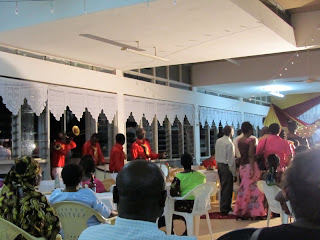On Saturday night I was fortunate enough to attend another community celebration, this time a wedding for two of the members of the Mzumbe community. The couple that was married was Abel Simon Mtali (a former Mzumbe Secondary School teacher) and Magdalena Hadija Katakweba. To be honest, I didn’t know either the bride or groom personally, but as a member of the Mzumbe community I was welcome to attend along with the rest of the Mzumbe staff. Of course I was more than happy to attend to experience how a traditional African wedding compared to weddings I’ve attended in the U.S. While there were some similarities to American traditional weddings, overall it was quite a different experience that exhibited many of the hallmarks of Tanzanian tradition that I have come to understand and appreciate.
 |
| Wedding Invitation- In English and Kiswahili |
Last week I received my invitation that welcomed everyone to the ceremony, which was held in Morogoro town and to the reception held at the nearby Mzumbe University campus. Since the church in town where the ceremony was held was not easy to get to from Mzumbe, most of the invited guests (including myself) did not attend the formal ceremony. However, at the reception there was a video broadcast of the ceremony so it was possible to see a bit of the wedding ceremony as it occurred earlier that day.
The invitation noted that the reception was to begin at 7PM at the reception hall at Mzumbe University, but since this is Tanzania where there is no hurry, most people did not arrive until around 8:30PM. There were chairs set out facing an elaborate display, including a head table for the wedding party and an open floor. After an hour when most of the guests had gathered and were socializing a bit, the reception ceremony began. As is traditional with most of these ceremonies I have attended, there was a Master of Ceremonies (usually a friend of the family) who proceeded over the events. First, she called each of the bride and groom’s families to enter the hall, and as each family came in they were dancing while accompanied by a brass band. Following the family entrances the wedding party entered in a similar fashion. Once everyone was inside, it was time for the bride and groom to enter. All of the guests crowded the entrance and as the band started to play the newlyweds entered as the guests cheered and welcomed them in.
 |
| The Family Entrance and Brass Band |
 |
| The Reception Hall |
 |
| The Bride and Groom Cutting the Cake |
After the entrances, the MC welcomed members of each family to say a few words for the bride and groom. This was followed by the cutting of the cake and also a toast to the bride and groom from all of the guests. After the toast, all of the guests lined up and went to toast the bride and groom one by one. At about Midnight it was (finally) time to eat dinner. Everyone lined up in the back of the hall and we were treated to a large plate of delicious food including all the traditional foods like rice, pilau, chicken, beef, bananas and watermelon. Once everyone enjoyed their meal, there were a couple of final proceedings to take place. The MC called upon the each of the families to come up and present their gifts to the bride and groom. Dancing to music, each family brought up their gifts including a new refrigerator, and kitchenware and some linen. After that, anyone else who had gifts to present the bride and groom were called up as well. Finally, at about 2AM the reception ended after a short performance from the brass band and some closing remarks from the MC.
 |
| Presenting the Gifts to the Newlyweds |
As always, I was thrilled to be a part of yet another community celebration and experience the traditions of Tanzania. It was a great event, and like the other ceremonies I have been fortunate to attend I was amazed at the warm welcome and sense of community that is such a big part of Tanzanian (and African) culture. It was a fun and truly festive celebration for the new couple and I am grateful to have experienced it during my time here.










